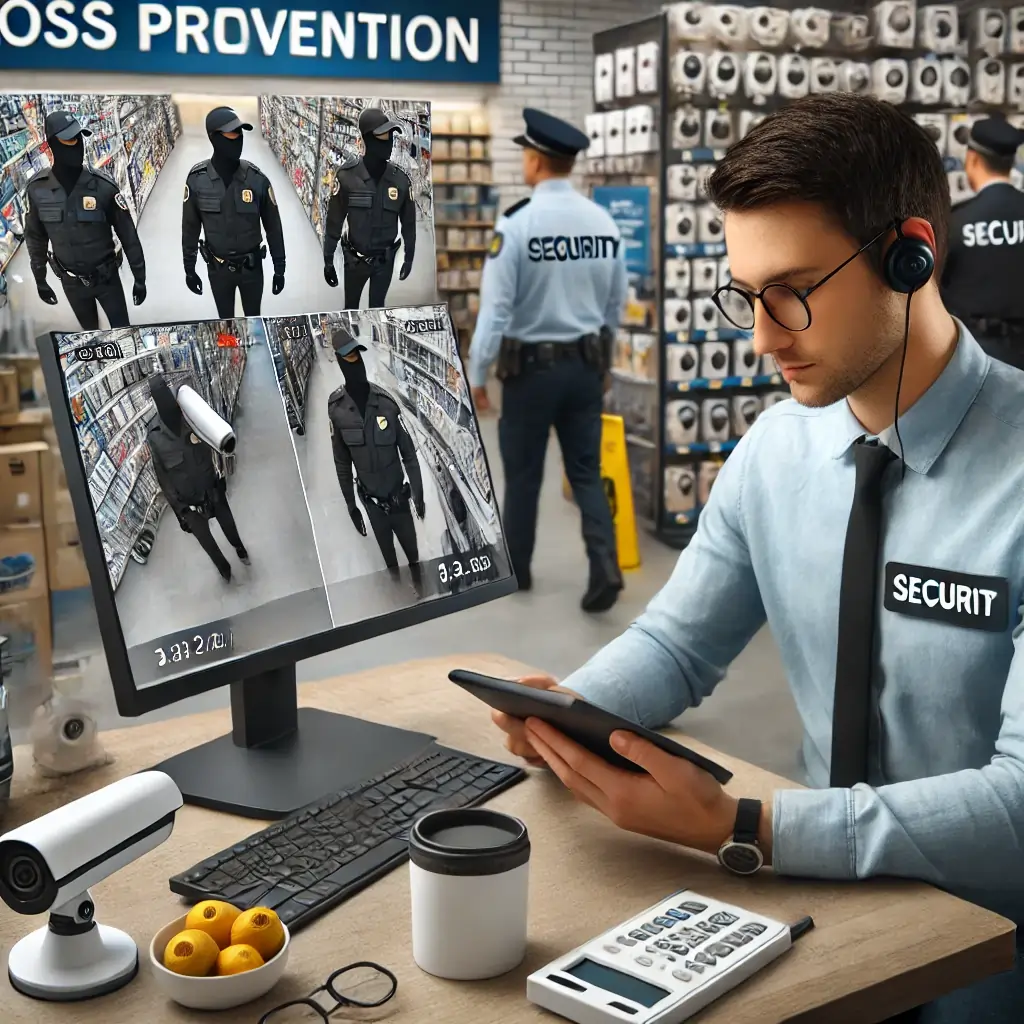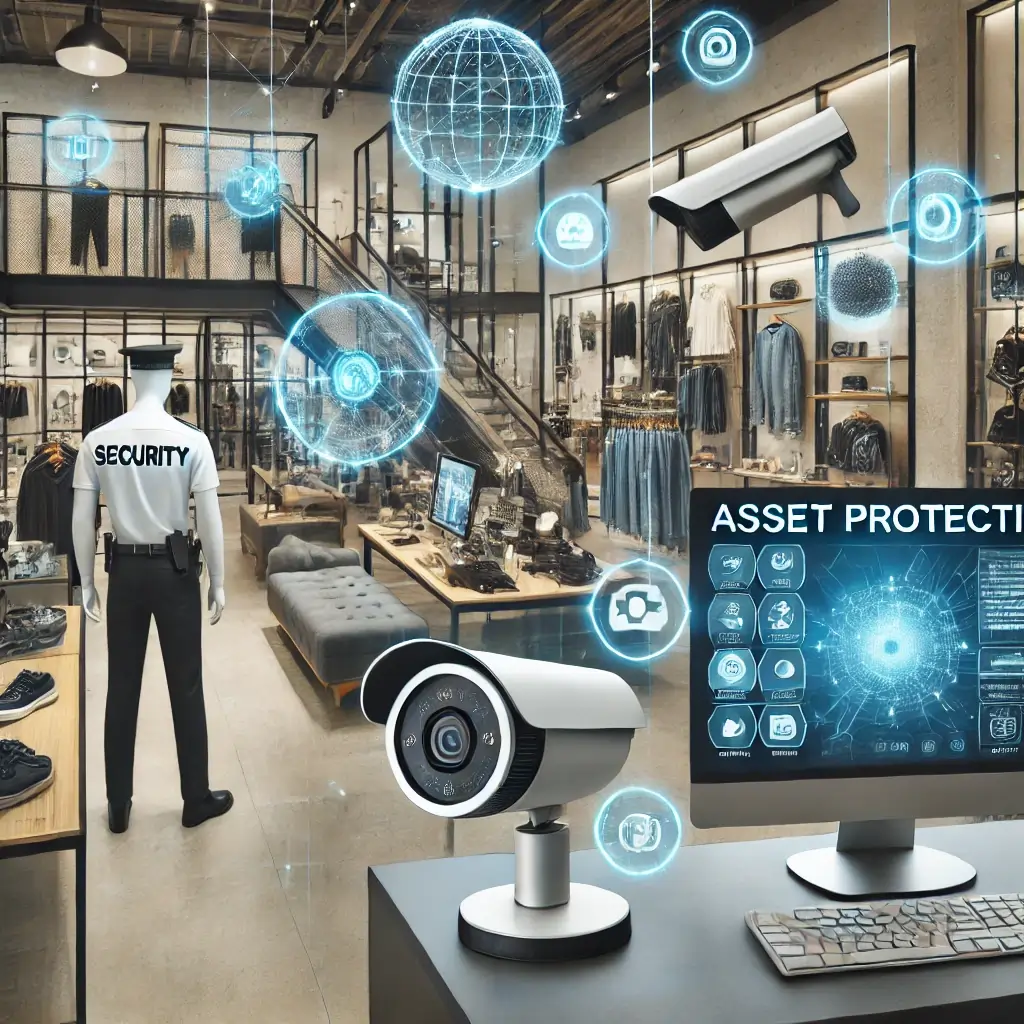Retail security has never been more critical than it is today. As technology evolves, so do the methods used by criminals to exploit vulnerabilities in stores and e-commerce platforms. Retailers face constant threats from shoplifters, organized retail crime (ORC), employee theft, and cyber fraud, making loss prevention a top priority. In a highly competitive industry where profit margins can be tight, reducing theft and loss is essential for sustainability and growth.
Security measures have long been a part of retail operations, but the nature of threats is changing rapidly. Traditional shoplifting, once the primary concern, has given way to more sophisticated crimes such as return fraud, digital payment scams, and large-scale theft operations. Criminals are leveraging advanced technology, making it necessary for retailers to adopt smarter and more proactive security strategies. The COVID-19 pandemic further accelerated these challenges, with shifts in consumer behavior driving more online transactions and increasing the risk of digital fraud. Meanwhile, in brick-and-mortar stores, self-checkout kiosks and reduced staff presence have created new opportunities for theft.
To counter these evolving threats, retail security is undergoing a technological transformation. Artificial intelligence (AI), machine learning, and predictive analytics are now playing a crucial role in detecting suspicious activities and preventing theft. Smart surveillance systems, equipped with facial recognition and behavioral analysis, allow retailers to identify repeat offenders and deter criminal activity. Electronic Article Surveillance (EAS) tags and RFID technology help track inventory in real-time, reducing shrinkage. Additionally, digital payment solutions and biometric authentication are enhancing security by minimizing the risks associated with cash handling and fraudulent transactions.
Cybersecurity has also become an essential component of retail security. As retailers collect vast amounts of customer data through loyalty programs and online sales, protecting this information from data breaches is crucial. Implementing robust encryption, multi-factor authentication, and real-time fraud detection systems can safeguard both businesses and consumers from cyber threats.
The future of retail security lies in a seamless integration of technology and human vigilance. While advanced security measures are necessary, they must be implemented in a way that does not compromise the customer experience. Retailers must strike a balance between ensuring safety and maintaining a welcoming shopping environment. By leveraging innovation, training staff, and staying ahead of emerging threats, businesses can create a secure and efficient retail landscape.
In this article, we will explore the latest advancements in retail security, from AI-powered surveillance to digital fraud prevention, and examine how these innovations are shaping the future of loss prevention.
Understanding Retail Theft and Loss
Retail theft and loss remain significant challenges for businesses worldwide. Whether through shoplifting, employee theft, or fraudulent transactions, these crimes result in billions of dollars in losses each year. As criminals become more sophisticated, retailers must stay vigilant and implement effective strategies to combat theft. Understanding the different types of retail crime, their impact on businesses, and the latest statistics on loss prevention is crucial for developing a strong security strategy.
Common Types of Retail Crime
Shoplifting – One of the most prevalent retail crimes, shoplifting occurs when individuals steal merchandise from a store without paying. Shoplifters range from opportunistic thieves taking small items to organized groups that steal large quantities of high-value goods for resale. Tactics include concealment, price tag switching, and using booster bags (specialized bags designed to bypass security sensors).
Employee Theft – Internal theft is a serious concern, as employees have direct access to merchandise, cash registers, and sensitive information. Some common forms of employee theft include under-ringing transactions, issuing fake refunds, stealing cash from registers, and taking inventory from stockrooms. Studies show that internal theft often results in higher losses than external shoplifting.
Fraudulent Activities – Retail fraud comes in various forms, including return fraud, credit card fraud, and counterfeit payments. In return fraud, criminals exploit store return policies by returning stolen or counterfeit items for cash or store credit. Credit card fraud involves the use of stolen card information to
make unauthorized purchases, while counterfeit payments include fake bills or fraudulent digital transactions.
Organized Retail Crime (ORC) – Unlike petty theft, ORC involves professional criminals who steal large quantities of merchandise and resell them through online marketplaces, flea markets, or black-market channels. ORC has become increasingly sophisticated, often involving fraud schemes, identity theft, and online scams.
The Impact of Theft on Businesses
Retail theft doesn’t just result in lost inventory—it affects nearly every aspect of a business. Financial losses from theft contribute to lower profit margins, forcing businesses to increase prices to compensate for shrinkage. Additionally, theft-related losses can impact employee wages, job security, and store expansion plans.
Beyond financial consequences, theft can also harm a retailer’s reputation. Frequent incidents of theft may create a perception that a store lacks proper security, making it an easy target for criminals. Customers may feel unsafe in stores with a high theft rate, leading to reduced foot traffic and lower sales. Moreover, employee morale can suffer if workers feel their workplace isn’t secure or if they are unfairly suspected of theft.
Key Statistics on Retail Loss Prevention
The National Retail Federation (NRF) estimates that retail shrink (losses due to theft, fraud, and errors) costs U.S. retailers nearly $100 billion annually.
Shoplifting and employee theft account for over 65% of retail shrink, making them the biggest contributors to losses.
Organized Retail Crime (ORC) has increased by over 25% in recent years, with losses exceeding billions annually.
Return fraud costs retailers an estimated $25 billion per year, with fraudulent online returns becoming more common.
As retail crime continues to evolve, businesses must stay ahead by implementing stronger security measures and leveraging technology to prevent losses.
Traditional Retail Security Measures
Retail security has always been a crucial aspect of business operations, ensuring that stores remain safe for both customers and employees while protecting valuable merchandise. Before the rise of modern technological solutions, traditional security measures played a central role in preventing theft and loss. While digital advancements have transformed retail security, many traditional methods are still in use today, often in combination with newer technologies.
This chapter explores three key traditional security measures: security guards and manual surveillance, locked display cases and physical barriers, and the role of customer service in theft prevention. These strategies have long been the backbone of retail security and continue to provide essential protection against theft.
Security Guards and Manual Surveillance
One of the oldest and most effective security measures in retail is the presence of security guards and the use of manual surveillance techniques. Physical security personnel serve as both a deterrent to potential thieves and a rapid-response solution when theft occurs.
The Role of Security Guards
Security guards are responsible for monitoring store activity, identifying suspicious behavior, and taking action when necessary. Their presence alone can significantly reduce theft, as shoplifters are less likely to target a store with visible security personnel. Guards are trained to handle a variety of situations, including:
- Observing customers for suspicious behavior
- Responding to security breaches or alarms
- Escorting disruptive or suspected thieves out of the store
- Conducting bag checks or monitoring entry and exit points
Security guards are particularly useful in high-theft environments, such as department stores, electronics retailers, and high-end boutiques. Their ability to react in real-time makes them an essential component of a store’s security strategy.
Manual Surveillance Techniques
Before the widespread use of security cameras and AI-powered analytics, store personnel relied heavily on manual surveillance to monitor theft. Some of the key techniques include:
Undercover store detectives – Plainclothes security personnel blend in with shoppers to observe theft attempts discreetly.
Observation training for employees – Staff members are trained to recognize body language and behaviors commonly associated with theft, such as loitering, excessive bag use, or frequent visits without making a purchase.
Strategic store layout – Placing high-value items in well-lit, heavily trafficked areas where employees can easily observe them.
While manual surveillance is effective, it does have limitations. Human error, bias, and fatigue can make it challenging to monitor all activity in a busy store. This is why many retailers today supplement security personnel with CCTV cameras and AI-driven monitoring systems.
Locked Display Cases and Physical Barriers
Another common traditional security measure is the use of locked display cases, security tags, and physical barriers to prevent direct access to valuable items.
Locked Display Cases
High-value or easily stolen merchandise, such as jewelry, electronics, and designer goods, are often stored in locked glass cases. Customers must request assistance from store employees to view or purchase these items. Locked display cases offer several benefits:
- Prevents grab-and-run theft – Since customers cannot access the products without assistance, it reduces the risk of quick theft attempts.
- Adds an extra layer of deterrence – Shoplifters are less likely to target items that require additional effort to steal.
- Improves inventory control – Employees keep track of how many products are being accessed, reducing opportunities for internal theft.
However, locked display cases can also impact the customer experience. Customers may find it inconvenient to wait for an employee to unlock a case, potentially leading to lost sales. Retailers must strike a balance between security and accessibility by ensuring staff are available to assist quickly.
Physical Barriers and Store Layout Design
Retailers often design store layouts with security in mind, using physical barriers and strategic store organization to minimize theft. Some effective tactics include:
- Placing registers near exits – This makes it more difficult for shoplifters to walk out unnoticed.
- Using security gates and entrance restrictions – Some stores have one-way entry and exit points to control customer movement.
- Installing mirrors and open-floor designs – Wide aisles, fewer blind spots, and strategically placed mirrors allow employees to maintain a clear line of sight throughout the store.
By making it harder for thieves to move undetected, physical barriers help reduce the risk of shoplifting and organized retail crime.
The Role of Customer Service in Theft Prevention
Surprisingly, one of the most effective security measures is excellent customer service. Engaging with customers not only improves their shopping experience but also serves as a powerful deterrent to theft.
How Customer Service Prevents Theft
- Acknowledging customers upon entry – Greeting every customer as they enter the store sends a clear message that employees are attentive and aware of their presence. Thieves prefer anonymity, so this simple action can discourage them.
- Offering assistance – Employees who actively approach customers and ask if they need help create a sense of vigilance that makes theft more difficult.
- Regularly patrolling the store – Staff members walking around the sales floor demonstrate that the store is well-monitored.
- Training employees to recognize suspicious behavior – Retail staff should be educated on common theft tactics, such as loitering, frequent visits without purchasing, excessive handling of items, or entering with large empty bags.
Building a Security-Conscious Team
For customer service to be an effective theft deterrent, retailers must ensure that all employees understand their role in security. This includes:
- Providing training on loss prevention – Teaching staff how to identify and respond to potential theft situations.
- Encouraging communication – Employees should feel comfortable reporting suspicious activity to management or security personnel.
- Creating a team-based approach – Security is more effective when all employees take an active role in preventing theft, rather than relying solely on dedicated security staff.
While customer service is a passive security measure, it remains one of the most cost-effective and efficient ways to deter shoplifting without the need for expensive technology or additional security staff.
The Rise of Smart Surveillance Systems
Retail security has evolved significantly over the past decade, with smart surveillance systems leading the charge in loss prevention and theft deterrence. Traditional security methods, such as security guards and manual monitoring, have their limitations, including human error and limited coverage. However, AI-powered cameras, real-time monitoring, and automated alerts have revolutionized retail security by providing greater accuracy, efficiency, and scalability.
This chapter explores the rise of smart surveillance systems, focusing on AI-powered cameras and facial recognition, real-time monitoring, and case studies of retailers using smart surveillance to reduce theft and improve overall security.
AI-Powered Cameras and Facial Recognition
One of the most significant advancements in retail security is the use of artificial intelligence (AI) in surveillance cameras. AI-powered security systems are designed to analyze real-time video footage, recognize suspicious behavior, and even identify known offenders.
How AI-Powered Cameras Work
Traditional security cameras require constant human monitoring, which can lead to missed incidents due to fatigue or distraction. AI-powered cameras, on the other hand, use machine learning algorithms to automatically:
- Detect unusual activity – AI analyzes customer behavior patterns and identifies potential threats, such as loitering, concealment of merchandise, or repeated visits by suspicious individuals.
- Recognize faces – Facial recognition technology can compare individuals against a database of known shoplifters or repeat offenders, instantly alerting security personnel.
- Track movement – AI can follow a suspect’s movements across multiple camera feeds, providing a clearer picture of potential criminal activity.
The Role of Facial Recognition in Retail Security
Facial recognition is becoming a controversial but effective tool in retail security. It allows retailers to:
- Identify repeat offenders – If a previously caught shoplifter returns, the system can flag their presence and alert security.
- Recognize employees and VIP customers – The technology isn’t just for loss prevention; it can also help with employee verification and personalized customer experiences.
- Reduce false alarms – AI can distinguish between genuine threats and normal customer behavior, minimizing unnecessary interventions.
However, the use of facial recognition raises privacy concerns. Many consumers worry about their personal data being stored and analyzed without consent. To address these concerns, retailers must ensure compliance with privacy regulations and obtain customer trust through transparent policies.
Real-Time Monitoring and Automated Alerts
Another critical benefit of smart surveillance systems is their ability to provide real-time monitoring and instant alerts, significantly improving response times.
How Real-Time Monitoring Works
AI-enhanced surveillance systems can monitor multiple areas of a store simultaneously, ensuring that no blind spots go unnoticed. Features include:
- Live video feeds accessible on mobile devices – Store managers and security teams can monitor the premises remotely, allowing for faster decision-making.
- Automated theft detection – When the AI detects suspicious behavior, it can send real-time alerts to store personnel or security teams, allowing them to intervene before theft occurs.
- Behavioral analysis – AI can differentiate between normal shopping behaviors and potentially suspicious activities, reducing false alarms and improving efficiency.
Benefits of Automated Alerts
Automated alerts significantly enhance retail security by:
- Providing instant notifications – When a suspicious individual is detected, security teams can receive instant alerts via text, email, or security system dashboards.
- Reducing response times – Faster responses can prevent theft before it happens, minimizing losses.
- Increasing accuracy – AI-powered alerts reduce reliance on human observation, leading to fewer missed incidents and more precise security measures.
By integrating AI-driven real-time monitoring and automated alerts, retailers can stay ahead of potential security threats and ensure a safer shopping environment.
Case Studies: Retailers Using Smart Surveillance
Many retailers have already embraced AI-powered surveillance technology to combat theft and loss. Here are three real-world examples of how smart surveillance systems are making a difference.
1. Walmart’s AI-Powered Loss Prevention
Walmart, one of the largest retail chains in the world, has implemented AI-powered cameras at checkout lanes to prevent theft and cashier errors.
The system, known as Missed Scan Detection, uses AI to monitor transactions in real-time.
If an item is not scanned properly (intentional or accidental), the system alerts store associates.
This technology has significantly reduced both accidental errors and theft, improving overall inventory accuracy.
Walmart’s AI surveillance has helped the company save millions of dollars in lost revenue while streamlining checkout processes.
2. Amazon Go and Automated Store Monitoring
Amazon Go stores operate using automated checkout technology known as Just Walk Out. This system uses:
AI-driven sensors and cameras to track customer movements.
Real-time product detection to determine what customers pick up or put back.
Seamless billing through the Amazon app, eliminating the need for physical checkout.
While primarily designed for convenience, this technology also serves as a powerful theft prevention tool by eliminating opportunities for shoplifting.
3. Home Depot’s Facial Recognition for Repeat Offenders
Home Depot has introduced facial recognition technology in select locations to combat organized retail crime.
The system identifies known shoplifters and repeat offenders as soon as they enter the store.
It alerts security personnel immediately, allowing them to monitor the suspect closely or take preemptive action.
The technology has helped Home Depot reduce theft incidents significantly, particularly in areas prone to high crime rates.
By integrating facial recognition with real-time monitoring, Home Depot has been able to deter repeat criminals and protect its assets more effectively.
The Future of Smart Surveillance in Retail
The rise of AI-powered surveillance systems has transformed retail security, making theft detection faster, more accurate, and more proactive than ever before. With AI-powered cameras, facial recognition, real-time monitoring, and automated alerts, retailers can:
- Reduce losses due to theft
- Enhance store security and safety
- Improve customer and employee experiences
However, retailers must balance security with privacy concerns, ensuring that customers feel safe without being overly surveilled. The key to successful implementation lies in transparency, compliance with data protection laws, and ethical use of technology.
Electronic Article Surveillance (EAS) and RFID Technology
Retailers face constant challenges in protecting their merchandise from theft and inventory shrinkage. To combat these issues, many have turned to Electronic Article Surveillance (EAS) and Radio Frequency Identification (RFID) technology. These advanced security solutions offer real-time tracking, theft deterrence, and enhanced inventory management, making them essential tools for modern retail security.
This chapter explores how RFID technology works, the advantages of EAS tags, and future enhancements in RFID tracking, helping retailers stay ahead in the fight against theft and loss.
How RFID Technology Works in Retail Security
Radio Frequency Identification (RFID) is a wireless technology that uses radio waves to transfer data between a tag attached to an item and a reader that detects and processes the information. Unlike traditional barcodes, RFID does not require line-of-sight scanning, making it more efficient and versatile for retail security and inventory management.
Key Components of RFID Technology
- RFID Tags – Small electronic devices attached to merchandise that store product information and transmit signals when scanned.
- RFID Readers – Devices installed at store entrances, exits, or shelves that detect RFID tags and record their movement.
- Antenna – Helps transmit signals between the RFID tag and the reader.
- RFID Software – The backend system that processes and analyzes the collected data, helping retailers track inventory and potential theft.
How RFID Enhances Retail Security
RFID technology is a game-changer for retail security in several ways:
- Theft Detection – RFID tags can trigger alerts if an item leaves the store without being properly deactivated or purchased.
- Real-Time Inventory Tracking – Retailers can monitor stock movement in real-time, making it easier to detect stolen or misplaced items.
- Faster Audits and Stock Checks – Unlike barcodes, which require scanning each item individually, RFID allows for batch scanning, significantly reducing the time needed for inventory counts.
- Better Loss Prevention Strategies – Retailers can analyze RFID data to identify high-theft areas in the store and adjust security measures accordingly.
With these capabilities, RFID provides a more accurate, efficient, and scalable approach to retail security than traditional barcode systems.
The Advantages of EAS Tags for Preventing Theft
While RFID technology is excellent for inventory tracking, Electronic Article Surveillance (EAS) remains one of the most effective deterrents against shoplifting. EAS is a security system that uses specialized tags and detection antennas to prevent theft.
How EAS Systems Work
- EAS Tags and Labels – These are attached to merchandise and must be deactivated at checkout using special tools.
- Detection Gates – Located at store exits, these gates detect active EAS tags and trigger an alarm if an item is taken without proper deactivation.
- Tag Deactivation or Removal – When a customer legally purchases an item, store employees deactivate or remove the EAS tag, allowing the customer to exit without setting off alarms.
Types of EAS Tags
Retailers use different types of EAS tags depending on the nature of their products:
- Magnetic Tags – Commonly used in apparel stores, these tags require special detachers at checkout.
- Radio Frequency (RF) Tags – These work similarly to RFID but are primarily designed for security rather than tracking.
- Acousto-Magnetic (AM) Tags – Ideal for electronics and high-value items, these tags provide a more reliable detection range.
- Disposable Paper Tags – Often used for books, cosmetics, and small items, these tags are deactivated at checkout.
Benefits of EAS in Retail Security
- Acts as a Strong Visual Deterrent – Shoplifters are less likely to steal items with visible security tags.
- Reduces Shrinkage – EAS systems significantly lower theft rates by preventing unpaid items from leaving the store.
- Requires Minimal Human Intervention – Unlike security guards or manual bag checks, EAS systems automatically detect stolen merchandise, reducing labor costs.
- Compatible with RFID Systems – Many modern EAS systems integrate with RFID tracking, offering a comprehensive loss prevention and inventory management solution.
The combination of RFID and EAS provides retailers with a powerful security framework that not only prevents theft but also improves operational efficiency.
Future Enhancements in RFID Tracking
While RFID has already transformed retail security, future advancements promise even greater accuracy, automation, and theft prevention capabilities. Here’s a look at what’s next for RFID technology:
1. AI-Driven RFID Analytics
Retailers are now integrating Artificial Intelligence (AI) with RFID data to detect suspicious behavior patterns.
AI algorithms can analyze store traffic, flag unusual activity, and alert security teams in real time.
This technology reduces false alarms and improves theft detection accuracy.
2. Blockchain for Secure RFID Data Storage
Blockchain technology ensures tamper-proof RFID records, preventing fraud or manipulation.
It creates a transparent, traceable history of each product’s journey from the warehouse to the checkout counter.
This is particularly useful for luxury brands and high-value merchandise, reducing counterfeiting and theft.
3. Ultra-Wideband (UWB) RFID for Precise Tracking
UWB RFID can pinpoint the exact location of tagged items within inches, making it ideal for tracking products inside large retail spaces.
This technology can help locate misplaced or stolen items faster, improving loss prevention efforts.
Retailers can geofence high-risk areas, triggering alerts if merchandise is moved without authorization.
4. RFID in Self-Checkout Theft Prevention
Self-checkout theft is a growing issue, but RFID-integrated self-checkout kiosks can ensure all scanned items are paid for before exiting.
AI-powered RFID systems can detect unscanned items in a shopper’s bag and prompt them to scan again.
Some stores are implementing RFID exit gates that only open when all items have been successfully checked out.
5. Integration with IoT (Internet of Things) for Smarter Retail Security
IoT-powered RFID tags can communicate with smart store shelves, inventory robots, and mobile apps.
Retailers can get instant notifications about stock levels, theft attempts, and even potential fraud cases.
IoT integration enhances automated restocking, predictive analytics, and overall store security.
With these advancements, RFID technology will continue to redefine retail security, making theft prevention smarter, faster, and more efficient.
Advanced Access Control Systems
In the ever-evolving landscape of retail security, advanced access control systems have become essential for preventing unauthorized access to restricted areas and enhancing overall safety. From biometric security solutions to smart locks and integrated access control systems, these technologies ensure that only authorized individuals can enter specific locations, minimizing internal theft and security breaches.
This chapter delves into how biometric authentication, smart locks, and integrated access control are revolutionizing security in retail environments.
Biometric Security in Retail Environments
Biometric security is one of the most reliable and sophisticated access control methods available today. Instead of using traditional keys, passwords, or access cards, biometric systems rely on unique biological traits such as fingerprints, facial recognition, retina scans, or voice patterns to verify identities.
Types of Biometric Security Used in Retail
- Fingerprint Scanners – Employees use their fingerprints to gain access to stockrooms, cash offices, and high-value merchandise areas.
- Facial Recognition – AI-powered cameras recognize employees’ faces and grant access to secured zones.
- Retina and Iris Scans – Highly secure authentication used for high-risk areas, such as bank vaults within retail environments.
- Voice Recognition – Some stores implement voice-activated security systems for restricted areas.
Advantages of Biometric Security in Retail
- Eliminates Lost or Stolen Access Credentials – Unlike keycards or passwords, biometric data cannot be lost, stolen, or easily duplicated.
- Enhances Internal Security – Prevents unauthorized employee access to sensitive locations like cash vaults and back offices.
- Reduces Time Theft – Employees must be physically present to clock in, preventing time fraud and buddy punching.
- Increases Accountability – Each access attempt is logged, making it easier to track who enters and exits specific areas.
- Improves Customer Experience – Some retailers are using facial recognition for VIP customer identification, offering a personalized shopping experience.
Biometric security provides a higher level of protection while also streamlining retail operations, making it an increasingly popular choice for businesses focused on security and efficiency.
Smart Locks and Restricted Access Areas
Smart locks are another powerful tool in modern retail security. Unlike traditional locks, which require keys or mechanical access cards, smart locks use digital authentication methods such as PIN codes, mobile apps, NFC technology, or biometric verification.
How Smart Locks Improve Retail Security
- Remote Access Control – Store managers can lock or unlock doors remotely via mobile apps, preventing unauthorized access when they’re off-site.
- Time-Based Access – Employees can be granted access only during specific hours, reducing the risk of unauthorized entry outside of business hours.
- Auto-Locking Features – Ensures that doors automatically lock after a certain period, preventing accidental security breaches.
- Access Logs and Alerts – Every entry and exit is logged, allowing store managers to track movements and receive alerts for unauthorized access attempts.
Common Applications of Smart Locks in Retail
- Stockrooms and Inventory Areas – Limits access to authorized employees only, reducing internal theft.
- Cash Offices and Safes – Prevents unauthorized personnel from accessing sensitive financial assets.
- Employee Break Rooms – Ensures that only staff members can enter designated areas, improving workplace security.
- After-Hours Entry Points – Enhances security by allowing only designated personnel access to the store during non-business hours.
With smart locks and digital access management, retailers gain more control, flexibility, and oversight over their security measures, leading to a safer working environment.
How Access Control Integrates with Overall Security
For maximum effectiveness, access control systems must be integrated into a retailer’s broader security strategy. A well-designed system should work seamlessly with CCTV cameras, alarm systems, intrusion detection technology, and cybersecurity protocols.
1. Integrating Access Control with Surveillance Systems
Biometric authentication combined with AI-powered cameras can verify an employee’s identity before granting access to secured areas.
Smart locks linked to security cameras can trigger recordings whenever someone enters a restricted area, creating an added layer of protection.
Live monitoring allows security personnel to immediately respond to unauthorized access attempts.
2. Pairing Access Control with Alarm Systems
If an unauthorized individual tries to bypass a smart lock or biometric scanner, an alarm can be automatically triggered.
RFID and EAS tags can work alongside access control to prevent merchandise theft from restricted stockrooms.
Store managers can receive real-time notifications on mobile devices when unusual access patterns are detected.
3. Cybersecurity and Digital Access Control
With cloud-based access control systems, cybersecurity becomes a major consideration. To protect against hacking and unauthorized digital entry, retailers must implement:
- Multi-Factor Authentication (MFA) – Requires employees to verify their identity using multiple methods, such as a fingerprint scan plus a PIN code.
- Encrypted Data Transmission – Prevents cybercriminals from intercepting access control data.
- Regular Software Updates – Keeps smart lock systems and biometric readers protected against vulnerabilities.
- User Access Audits – Ensures that only current employees have active credentials, reducing security risks from former staff members.
By integrating physical security (locks, cameras, alarms) with digital security (biometrics, cloud-based access management, and encryption), retailers can create a comprehensive, future-proof security system.
AI and Machine Learning in Retail Security
As the retail industry continues to evolve, so do the threats it faces. Theft, fraud, and inventory loss remain significant challenges for businesses. Traditional security measures, while effective, often fall short in preventing incidents before they occur. This is where Artificial Intelligence (AI) and Machine Learning (ML) are transforming retail security by providing predictive analytics, automated loss prevention strategies, and real-time threat detection.
This chapter explores how AI-driven security solutions help retailers stay ahead of theft and fraud through predictive analytics, advanced monitoring, and automated security interventions.
Predictive Analytics for Theft Detection
One of the most powerful applications of AI in retail security is predictive analytics, which helps identify potential threats before they occur. Unlike traditional security methods that react after a theft happens, AI-powered systems analyze vast amounts of real-time data to detect suspicious behaviors.
How Predictive Analytics Works in Retail Security
AI algorithms are trained to recognize patterns in customer behavior, employee actions, and store activities. These systems analyze data from multiple sources, including:
- Surveillance footage – AI can track customer movement and detect anomalies in behavior.
- Point-of-sale (POS) transactions – AI detects unusual transaction patterns, such as fraudulent returns or unauthorized discounts.
- Inventory management systems – AI monitors stock levels and flags discrepancies in real-time. Customer
- movement data – AI-powered analytics can detect when a person loiters near high-value items, signaling a potential theft risk.
Once an AI system identifies a high-risk situation, it can trigger real-time alerts to store managers, allowing them to intervene before a theft occurs.
Examples of Predictive Theft Detection in Action
- Facial Recognition for Repeat Offenders – AI-powered cameras can identify known shoplifters and alert security personnel as soon as they enter the store.
- Behavior Analysis – AI can recognize behaviors commonly associated with shoplifting, such as frequent scanning of security cameras, rapid bagging of items, or nervous pacing.
- Internal Theft Prevention – Predictive analytics can detect suspicious employee actions, such as frequent manual price overrides or excessive refunds.
By leveraging AI-driven predictive analytics, retailers can reduce losses, protect merchandise, and enhance store safety without relying solely on manual intervention.
AI-Driven Loss Prevention Strategies
Beyond theft detection, AI plays a crucial role in proactive loss prevention. Retailers can automate security protocols, track inventory more accurately, and reduce fraudulent transactions using AI-powered tools.
1. AI-Powered Video Analytics
AI-based video surveillance systems can analyze thousands of hours of footage in real time, identifying suspicious activities without the need for constant human monitoring. These systems can:
Detect shoplifting patterns, such as concealing merchandise or switching price tags.
Recognize familiar faces—both known offenders and repeat customers.
Alert security personnel to crowded or high-risk areas where theft is more likely.
2. Automated Fraud Detection at Checkout
AI-driven POS security solutions help prevent fraud by:
- Identifying fake returns and suspicious refund requests.
- Detecting unauthorized employee transactions, such as price manipulation.
- Monitoring unusual discount patterns that may indicate fraud.
For example, machine learning algorithms can analyze past transactions and flag any deviation from normal purchasing behavior, helping retailers minimize losses from fraudulent activities.
3. Inventory Management with AI
AI helps prevent stock losses by improving inventory accuracy and reducing shrinkage. Some retailers use:
- RFID-powered AI tracking to monitor inventory movements in real time.
- Automated restocking alerts to prevent misplaced or unaccounted-for merchandise.
- Theft pattern analysis to adjust security measures based on high-risk products.
By integrating AI into inventory tracking, retailers can detect and address losses before they impact the bottom line.
Real-World Applications of AI in Retail Security
Many leading retailers are already leveraging AI-powered security solutions to enhance protection, optimize operations, and reduce financial losses.
1. Walmart’s AI-Powered Surveillance
Walmart has implemented AI-driven video surveillance to track checkout activity and prevent theft. The system, known as Missed Scan Detection, monitors self-checkout lanes and alerts staff if an item is placed in a bag without being scanned.
Results: This AI-driven solution has significantly reduced self-checkout fraud and operational losses.
2. Amazon Go’s Cashierless AI Stores
Amazon Go stores utilize AI-powered cameras and sensors to track what customers pick up and charge them automatically when they leave the store.
Benefits:
- Eliminates shoplifting risks since customers must be linked to a valid payment account.
- Reduces operational costs by removing traditional checkout lanes.
- Improves customer convenience with a frictionless shopping experience.
3. Target’s Predictive Theft Detection
Target employs AI-driven predictive analytics to monitor security camera footage and detect potential shoplifters based on behavior patterns. Security teams receive real-time alerts when suspicious activity is detected, allowing them to intervene before theft occurs.
In the next chapter, we will explore how cybersecurity and AI work together to protect both physical stores and digital transactions from fraud and data breaches.
Mobile Security and Cashless Payments
With the rapid advancement of digital technology, the retail industry is shifting away from cash-based transactions toward mobile payments and cashless systems. This transformation enhances customer convenience while significantly improving security measures by reducing theft, fraud, and financial mismanagement.
In this chapter, we’ll explore how cashless payments reduce theft, mobile payment apps strengthen security, and the future of digital transactions in retail.
Reducing Cash-Related Thefts Through Digital Payments
One of the biggest security challenges for retailers has historically been cash handling. Stores that deal heavily in cash transactions are prime targets for robberies, internal theft, and financial fraud. Cash can be easily stolen, mishandled, or miscounted, leading to revenue losses.
How Cashless Payments Reduce Theft Risks
- No Physical Cash to Steal – When a business operates on a digital payment system, criminals have no physical cash to target. This makes armed robberies and burglaries far less attractive.
- Reduced Internal Theft – Employee theft is a common issue in retail. With digital transactions, every sale is electronically tracked, making it difficult for employees to manipulate cash registers or underreport earnings.
- Fewer Counterfeit Scams – Cash-based businesses must always be on guard against counterfeit currency. Cashless payments eliminate this risk entirely.
- Secure Audit Trails – Digital transactions create automatic records, making it easier for businesses to track sales, monitor for fraud, and reconcile discrepancies.
For these reasons, major retailers and small businesses alike are embracing cashless payment solutions to enhance security while streamlining operations.
How Mobile Payment Apps Enhance Security
Mobile payment apps like Apple Pay, Google Pay, PayPal, and digital wallets offer greater security protections compared to traditional cash and card transactions. These apps use advanced encryption and authentication methods to prevent fraud and unauthorized access.
Key Security Features of Mobile Payment Apps
1.Tokenization Technology
When a customer pays using a mobile app, their credit card number is never directly transmitted. Instead, a one-time-use token is generated for that specific transaction. This means even if hackers intercept the data, they can’t use it for fraudulent purchases.
2.Biometric Authentication
Many mobile payment apps require fingerprint scans, facial recognition, or PIN authentication before a transaction is processed. This adds an extra layer of security, making it nearly impossible for unauthorized users to access an account.
3.Real-Time Fraud Detection
AI-powered fraud detection systems monitor transactions in real time, flagging any suspicious activity. For example, if an unusual or high-risk transaction is detected, the app may require additional authentication or temporarily block the transaction.
4.Contactless and Secure Transactions
With NFC (Near-Field Communication) technology, mobile payments allow customers to tap their phone instead of inserting a card or handling cash. This minimizes the risk of card skimming and ATM fraud.
5.Remote Account Locking
If a smartphone is lost or stolen, users can remotely disable their mobile payment accounts. This ensures that unauthorized users cannot make purchases, unlike physical cash or credit cards, which can be stolen and used immediately.
Retailers That Have Successfully Implemented Mobile Payments
1.Starbucks – One of the pioneers in mobile payments, Starbucks’ app allows customers to preload money, earn rewards, and make quick transactions without using cash.
2.Walmart Pay – Walmart’s own mobile payment system enhances security by requiring in-app verification before a transaction is approved.
3.Amazon Go – Amazon’s cashierless stores use AI and mobile payments to create a frictionless, cashless shopping experience.
The Future of Retail Transactions and Security
As cashless payments continue to grow, the future of retail security will see even more innovations in digital transactions. Retailers are investing in advanced security measures, blockchain technology, and AI-driven fraud prevention tools to create safer and more seamless shopping experiences.
1. The Rise of Biometric Payments
Retailers are beginning to experiment with biometric-based payment systems where customers can pay using:
1.Fingerprint scans – Customers can complete purchases by scanning their fingerprint, which is linked to their digital wallet.
2.Facial recognition – Some stores are testing AI-powered facial recognition payments, eliminating the need for physical devices.
3.Palm scanning – Amazon One uses palm recognition technology to allow customers to pay simply by hovering their hand over a scanner.
These biometric payment methods enhance security while making transactions faster and more convenient.
2. Blockchain-Powered Payment Security
Blockchain technology is being integrated into retail payment systems to provide tamper-proof transaction records. Some key advantages include:
1.Decentralized security – No single entity controls blockchain data, making it nearly impossible to hack or alter transactions.
2.Encrypted transactions – Every transaction is encrypted and verified through a network of secure nodes.
3.Smart contracts – Some retailers are exploring automated contracts that trigger payments only when conditions are met, reducing fraud risks.
3. AI-Powered Fraud Detection
As fraud tactics evolve, AI-driven fraud detection tools will become even more sophisticated. Future AI security systems will:
1.Analyze millions of transactions in real-time to spot fraud patterns.
2.Automatically flag unusual purchase behaviors and require additional authentication.
3.Use predictive analytics to prevent fraud before it happens.
4. The Expansion of Digital-Only Stores
With advancements in mobile security, some stores may transition entirely to digital payments. Countries like Sweden and China are already moving toward a cashless society, where most transactions occur through mobile apps or biometric payments.
Benefits of Digital-Only Stores:
1.Eliminates the need for cash registers
2.Speeds up checkout processes
3.Reduces security threats from robberies and theft
4.Creates seamless customer experiences
Retailers that adopt mobile payments and digital security measures will future-proof their businesses against fraud, theft, and evolving security threats.
Cybersecurity Threats in Retail
As retailers increasingly adopt digital payment systems, e-commerce platforms, and IoT-connected devices, they become more vulnerable to cybersecurity threats. From data breaches and digital fraud to hacking incidents, cybercriminals are constantly seeking ways to exploit weak security systems.
In this chapter, we’ll explore the rise of digital fraud in retail, strategies to protect customer data, and best practices for securing both online and in-store systems.
The Rise of Digital Fraud in Retail
As retail businesses move toward cashless transactions, mobile payments, and cloud-based operations, cybercriminals are shifting their focus to digital fraud.
Common Cyber Threats in Retail
1.Data Breaches – Cybercriminals target retailers’ databases to steal customer payment details, personal information, and login credentials.
2.Phishing Attacks – Hackers trick employees or customers into revealing sensitive information through fake emails, texts, or fraudulent websites.
3.Point-of-Sale (POS) Malware – Malicious software is installed on POS systems to capture credit card data during transactions.
4.E-skimming Attacks – Hackers inject malicious scripts into checkout pages of online stores to steal credit card details in real time.
5.Ransomware Attacks – Cybercriminals encrypt critical retail systems and demand ransom payments to restore access.
6.Account Takeover (ATO) Fraud – Hackers use stolen credentials to gain unauthorized access to customer accounts, enabling fraudulent purchases.
Impact of Cybercrime on Retailers
1.Financial Losses – A single data breach can cost retailers millions of dollars in legal fees, fines, and customer reimbursements.
2. Reputation Damage – Customers lose trust in retailers that fail to protect their sensitive information.
3.Operational Disruptions – Cyberattacks can shut down POS systems, disable e-commerce platforms, and disrupt supply chains.
4. Legal Consequences – Retailers can face hefty fines and lawsuits for failing to comply with data protection regulations like GDPR and PCI DSS.
To prevent these risks, retailers must implement robust security measures to protect both customer data and their internal networks.
Protecting Customer Data and Transaction Security
Retailers handle vast amounts of customer data, from credit card details and email addresses to shopping habits and personal preferences. Cybercriminals target this information for financial fraud, identity theft, and black-market sales.
1. Implementing End-to-End Encryption
End-to-end encryption ensures that sensitive customer data is fully protected from the moment a transaction begins until it is completed.
1.Payment Encryption – Every time a customer makes a purchase, their data should be encrypted to prevent hackers from intercepting payment details.
2.Tokenization Technology – Retailers should replace credit card numbers with unique, one-time-use tokens to prevent data theft.
3. SSL Encryption for Websites – E-commerce platforms must use SSL (Secure Sockets Layer) encryption to secure online transactions.
2. Strengthening Point-of-Sale (POS) Security
Retailers must protect POS terminals from malware attacks and unauthorized access.
1.Use Secure POS Software – Ensure that POS systems are regularly updated with security patches.
2.Implement Multi-Factor Authentication (MFA) – Require two-step authentication for POS access to prevent unauthorized logins.
3. Monitor POS Networks for Suspicious Activity – Use AI-driven fraud detection systems to identify potential threats in real-time.
3. Securing Customer Accounts
Hackers often target customer accounts to steal stored payment information and loyalty rewards.
1.Require Strong Passwords – Enforce complex password policies to prevent brute-force attacks.
2. Enable Biometric Authentication – Use fingerprint scanning or facial recognition for mobile payment security.
3. Use AI-Based Fraud Detection – Detect unusual purchasing behavior and flag suspicious transactions.
By securing customer transactions and accounts, retailers can minimize fraud risks and enhance consumer trust.
Best Practices for Retailers to Secure Online and In-Store Systems
Retailers need a comprehensive cybersecurity strategy to protect both brick-and-mortar stores and e-commerce platforms. Here are the best practices for securing retail operations:
1. Regularly Update Security Software
1.Apply Security Patches – Keep POS systems, mobile apps, and online platforms updated with the latest security patches.
2.Use Firewalls & Intrusion Detection – Prevent cyberattacks by blocking unauthorized access to networks.
3. Install Anti-Malware Protection – Protect against spyware, ransomware, and keyloggers.
2. Train Employees on Cybersecurity Awareness
1. Recognize Phishing Scams – Teach employees how to identify fake emails and suspicious links.
2.Enforce Secure Login Practices – Require employees to use strong passwords and MFA for business accounts.
3. Limit Access to Sensitive Data – Implement role-based access controls to restrict unauthorized personnel from viewing customer payment data.
3. Adopt Zero Trust Security Policies
1.Verify Every Access Request – Implement a zero-trust model where every login or transaction requires verification.
2.Segment Networks – Separate customer data from internal business operations to prevent large-scale breaches.
3. Monitor System Activity in Real Time – Use AI-based analytics to detect and prevent cyber threats before they cause damage.
4. Comply with Industry Security Standards
Retailers must follow strict cybersecurity regulations to avoid legal penalties and ensure customer data protection.
1.PCI DSS Compliance – Retailers processing credit card transactions must comply with the Payment Card Industry Data Security Standard (PCI DSS) to prevent card fraud.
2. GDPR & CCPA Compliance – For retailers operating in Europe and California, compliance with data protection laws is mandatory.
3. SOC 2 Certification – Implement best security practices for handling customer data in cloud-based retail environments.
5. Backup Data and Create a Response Plan
1.Schedule Automated Backups – Regularly back up critical data to prevent ransomware-related data loss.
2. Develop an Incident Response Plan – Retailers must have a clear cyberattack response strategy to quickly mitigate threats.
3. Conduct Penetration Testing – Simulate cyberattacks to test the strength of security defenses.
Integrating Security with Customer Experience
As retail security measures become more sophisticated, businesses must strike a balance between protection and convenience. Customers expect frictionless shopping experiences, and overly intrusive security measures can harm brand perception and sales. The challenge for retailers is to implement seamless security solutions that enhance safety and trust without disrupting the shopping experience.
Balancing Security and Convenience
Customers value security, but they also prioritize efficiency and ease of shopping. If security measures feel cumbersome or intrusive, they can lead to frustration, cart abandonment, or even loss of customer loyalty.
Common Retail Security Pain Points
1.Long Checkout Times – Excessive verification steps or outdated payment security can slow transactions.
2. Intrusive Bag Checks – Overly aggressive loss prevention measures can make honest customers feel like suspects.
3. False Alarms from EAS Systems – Frequent false triggers from security tags can cause embarrassment and inconvenience.
4. Security Personnel Perception – Poorly trained security staff can create a hostile or unwelcoming environment.
To maintain a positive shopping experience, retailers must implement subtle yet effective security strategies.
How Seamless Security Solutions Improve Customer Trust
Retailers that adopt invisible, frictionless security measures can improve both store safety and customer satisfaction.
1. AI-Powered Theft Prevention
Instead of relying on manual surveillance, retailers can use AI-driven smart cameras to detect suspicious behavior without disrupting the shopping experience.
1.Facial Recognition – Identifies repeat offenders without affecting regular customers.
2. Behavioral Analytics – AI systems detect unusual shopping patterns and alert staff discreetly.
2. Touchless and Cashless Payment Systems
Modern mobile wallets and biometric authentication ensure secure transactions without slowing down checkout.
1.NFC and QR Code Payments – Speed up transactions and reduce reliance on cash.
2. Biometric Authentication – Fingerprint or facial recognition enhances security without requiring PINs or passwords.
3. Smart Access Control
Retailers can use smart locks, RFID badges, and biometric scanners to secure restricted areas without disrupting employees or customers.
1.Seamless Store Access for VIP Customers – Membership-based access control enhances customer experience while reducing theft risks.
2. Automated Employee Authentication – AI-driven systems allow staff to access stockrooms securely without keycards.
By integrating invisible, smart security measures, retailers can create a safe and enjoyable shopping environment.
Future Trends in Customer-Centric Retail Security
Retail security will continue evolving to become more efficient, less intrusive, and highly customer-friendly.
1.Frictionless Checkout Stores – AI-powered stores, like Amazon Go, will eliminate traditional checkout processes.
2.Blockchain-Based Payment Security – More retailers will adopt blockchain for secure and tamper-proof transactions.
3.Augmented Reality (AR) Security Alerts – Employees may receive AR-enhanced real-time security updates on smart glasses or mobile devices.
By prioritizing customer convenience and trust, retailers can ensure security measures enhance rather than hinder the shopping experience.
The Future of Retail Security
The retail security landscape is rapidly evolving, with new technologies continuously emerging to combat theft, fraud, and cybersecurity threats. The next decade will witness AI-driven security, biometric authentication, blockchain solutions, and automation redefining how retailers protect their businesses.
Emerging Technologies in Loss Prevention
Retailers are adopting advanced technologies to minimize losses without disrupting operations.
1. AI and Predictive Analytics
AI-powered theft detection systems use machine learning algorithms to analyze shopping behaviors and flag potential shoplifters in real time.
1.Automated Threat Detection – AI detects unusual shopping patterns and sends alerts before theft occurs.
2.Facial Recognition for Repeat Offenders – Stores can identify known shoplifters without manual monitoring.
2. RFID and IoT-Based Tracking
RFID and IoT technologies will enhance real-time inventory tracking, reducing loss due to theft or mismanagement.
1. Self-Managing Inventory – Smart shelves will alert staff when items are moved suspiciously.
2. Real-Time Asset Tracking – IoT-enabled devices will help retailers locate missing or stolen merchandise instantly.
3. Blockchain for Secure Payments
Blockchain technology will strengthen payment security and prevent digital fraud.
1.Decentralized Transaction Records – Reduces the risk of credit card fraud and chargebacks.
2. Tamper-Proof Loyalty Programs – Ensures customer rewards and points cannot be hacked or manipulated.
Predictions for the Next Decade of Retail Security
The next ten years will see a major transformation in retail security strategies.
1.Automated Store Surveillance – AI-driven robots and drones will handle store monitoring and security enforcement.
2.Biometric-Only Transactions – Fingerprint and facial recognition will replace traditional PIN and password-based payments.
3.Cloud-Based Cybersecurity Measures – More retailers will move data security to the cloud, leveraging AI-driven fraud prevention tools.
4.Retailer Collaboration for Theft Prevention – Stores will share real-time theft data across retail networks to prevent organized crime.
Retail security will become smarter, more automated, and seamlessly integrated into the customer journey.
Final Thoughts on Adapting to Evolving Threats
To stay ahead of retail crime and digital fraud, businesses must adopt a proactive security strategy.
Leverage AI and automation to prevent theft before it happens.
Adopt frictionless security measures that enhance, rather than disrupt, customer experience.
Stay updated on emerging security trends, including blockchain, IoT, and predictive analytics.
Educate employees and customers on safe digital transactions and fraud prevention.
The future of retail security lies in smart, customer-friendly solutions that blend convenience with robust protection. Retailers that embrace next-generation security innovations will outpace threats, reduce losses, and build lasting customer trust.









